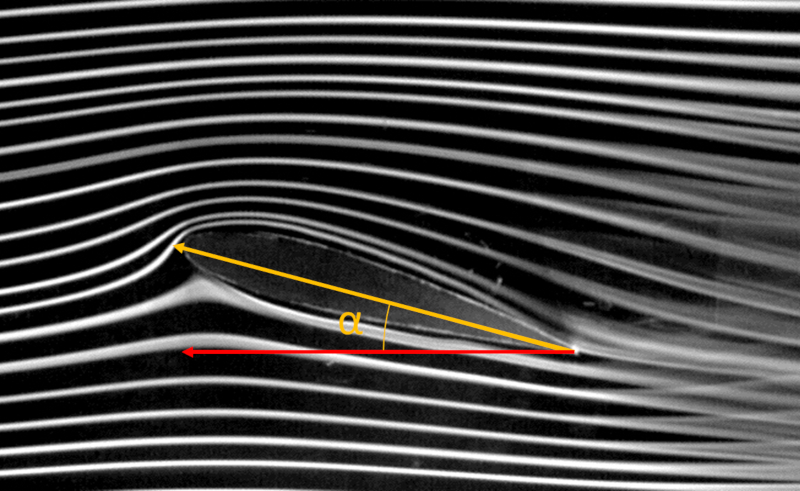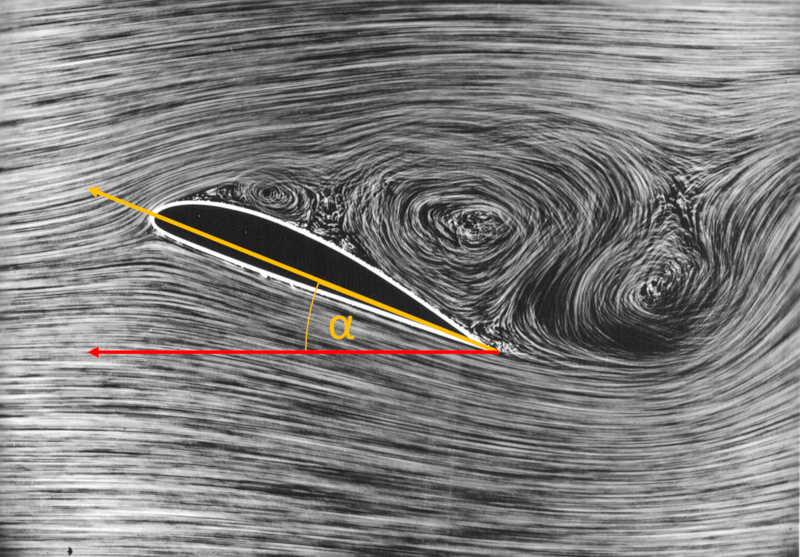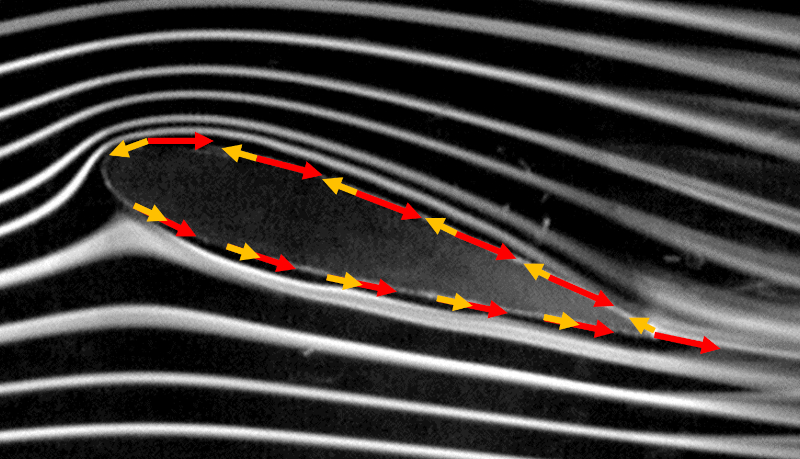Stall Effect
Storyboard 
If the angle of attack is very large, the whirlpools that form in the upper rear part of the wing tend to advance until they reach the upper edge at the beginning of the wing covering the entire upper part with whirlpools. In this condition the lift descends dramatically generating what is called the Stall effect and which can lead to an uncontrolled fall of the object (plane / bird).
There are situations in which both airplanes and birds have used this effect to carry out surprise attacks from high altitude developing a technique to re-control the flight and will not crash on the ground.
ID:(1462, 0)
Stall Effect
Storyboard 
If the angle of attack is very large, the whirlpools that form in the upper rear part of the wing tend to advance until they reach the upper edge at the beginning of the wing covering the entire upper part with whirlpools. In this condition the lift descends dramatically generating what is called the Stall effect and which can lead to an uncontrolled fall of the object (plane / bird). There are situations in which both airplanes and birds have used this effect to carry out surprise attacks from high altitude developing a technique to re-control the flight and will not crash on the ground.
Variables
Calculations
Calculations
Equations
The lift force ($F_L$), along with the wing span ($L$), the density ($\rho$), the wing top speed factor ($c_t$), the wing bottom speed factor ($c_b$), the upper wing length ($l_t$), the bottom wing length ($l_b$), and the speed with respect to the medium ($v$), is found in
If we consider the surface that generates lift ($S_w$), given by the wing span ($L$), the upper wing length ($l_t$), and the bottom wing length ($l_b$),
and for the coefficient of lift ($C_L$), defined as
we obtain
The lift force ($F_L$) along with the density ($\rho$), the surface that generates lift ($S_w$), the coefficient of lift ($C_L$), and the speed with respect to the medium ($v$) is represented as
which, along with the body mass ($m$) and the gravitational Acceleration ($g$), must be equal to:
that is:
$\displaystyle\frac{1}{2}\rho S_wC_Lv^2=mg$
resulting in:
The coefficient of lift ($C_L$) is calculated with the body mass ($m$), the gravitational Acceleration ($g$), the surface that generates lift ($S_w$), the density ($\rho$), and the speed with respect to the medium ($v$) as follows:
Therefore, with the proportionality constant coefficient sustainability ($c$) and the angle of attack of a wing ($\alpha$),
we have
Examples
The lift coefficient is a function of the angle of attack and typically follows the trend indicated in the following figure:
In the illustrated case, the slope is approximately 1.5 per 15 degrees, which corresponds to 0.1 1/degree or 5.73 1/radian.
In a wind tunnel model of a wing, one can observe how initially the flow is laminar, but as it progresses towards the wing's trailing edge, turbulent flow develops:
When the angle of attack exceeds a critical angle (typically between 15 and 30 degrees, depending on the design), the wing's surface becomes covered in vortices, and lift abruptly drops to zero.
At this point, a phenomenon known as a stall occurs, where the airflow over the wing separates, forming turbulent vortices. These vortices disrupt the smooth airflow, significantly reducing lift and affecting the aircraft's control capability. It is crucial to prevent the angle of attack from exceeding this critical value to maintain stable and safe flight.
If the angle of attack exceeds a critical angle (typically between 15 to 30 degrees, depending on the design), the wing surface becomes covered in vortices, and the lift abruptly drops to zero.
At this point, a phenomenon known as a stall occurs, where the airflow over the wing separates and turbulent vortices are generated. These vortices disrupt the smooth airflow, significantly reducing lift and affecting the aircraft's controllability. It is important to avoid surpassing this critical angle of attack to maintain stable and safe flight.
The flight of National Airlines 102, a Boeing 747-400 cargo aircraft departing from Bagram in Afghanistan, tragically crashed on April 29, 2013, due to a cargo shift during takeoff. The cargo displacement caused an increase in the angle of attack, leading to the wing's loss of lift, a phenomenon known as a stall. Additionally, the cargo shift damaged the hydraulic system of the tail rudders, rendering the aircraft uncontrollable. Regrettably, all 7 crew members lost their lives instantly upon impact.
Here is a simulation depicting the fateful takeoff: Simulation
To generate higher pressure below than above the wing and generate lift, Bernoulli's principle is employed, correcting for the lack of energy density conservation using ERROR:6119.1. The pressure over the wing, the lift force ($F_L$), can be estimated using the density ($\rho$), the surface that generates lift ($S_w$), the coefficient of lift ($C_L$), and the speed with respect to the medium ($v$) through the following formula:
From measurements, it is concluded that the lift coefficient $C_L$ is proportional to the angle of attack $\alpha$:
After a certain angle, the curve decreases until it reaches zero. This is because beyond that critical angle, the vortices fully cover the upper surface of the wing, leading to a loss of lift. This phenomenon is known as \"stall\".
The condition for achieving flight is met when the lift force ($F_L$) equals the weight of the aircraft or bird, which is calculated from the body mass ($m$) and the gravitational Acceleration ($g$). This is achieved with sufficient values of ERROR:6110,0, the surface that generates lift ($S_w$), and the coefficient of lift ($C_L$), where the latter coefficient is the adjustable factor. In the case of aircraft, pilots can modify the value of the coefficient of lift ($C_L$) using flaps, whose value must satisfy:
Flaps are adjusted by changing the angle that the wing makes with the direction of flight, known as the angle of attack.
Since the lift coefficient $C_L$ is proportional to the angle of attack $\alpha$, we can calculate the necessary angle to achieve sufficient lift for a given velocity $v$:
where $m$ is the mass, $g$ is the gravitational acceleration, $\rho$ is the density of the medium, $S_w$ is the wing area, and $c$ is the proportionality constant between the lift coefficient and the angle of attack.
ID:(1462, 0)




